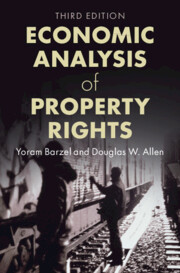Book contents
- Frontmatter
- Contents
- Figures
- Tables
- Preface to the Third Edition
- Preface to the Second Edition
- Preface to the First Edition
- Part I Conceptualissues
- 1 The Neoclassical Problem
- 2 Economic Property Rights
- 3 Transaction Costs
- 4 Information Costs
- 5 The Theory of Economic Property Rights
- Part II Contracts, Organizations, And Institutions
- 6 Exchange, Contracts, and Contract Choice
- 7 Divided Ownership and Organization
- 8 Institutions
- Part III Establishing Property Rights
- 9 Capture in the Public Domain
- 10 Forming Property Rights
- 11 Benefits of the Public Domain
- Part IV Non-Price Allocation And Other Issues
- 12 Nonwage Labor Markets
- 13 Property Rights in Non-market Allocations
- 14 Additional Property Rights Applications
- 15 The Property Rights Model
- References
- Index
- Political Economy of Institutions And Decisions
9 - Capture in the Public Domain
Published online by Cambridge University Press: 17 August 2023
- Frontmatter
- Contents
- Figures
- Tables
- Preface to the Third Edition
- Preface to the Second Edition
- Preface to the First Edition
- Part I Conceptualissues
- 1 The Neoclassical Problem
- 2 Economic Property Rights
- 3 Transaction Costs
- 4 Information Costs
- 5 The Theory of Economic Property Rights
- Part II Contracts, Organizations, And Institutions
- 6 Exchange, Contracts, and Contract Choice
- 7 Divided Ownership and Organization
- 8 Institutions
- Part III Establishing Property Rights
- 9 Capture in the Public Domain
- 10 Forming Property Rights
- 11 Benefits of the Public Domain
- Part IV Non-Price Allocation And Other Issues
- 12 Nonwage Labor Markets
- 13 Property Rights in Non-market Allocations
- 14 Additional Property Rights Applications
- 15 The Property Rights Model
- References
- Index
- Political Economy of Institutions And Decisions
Summary
Because economic property rights are not free, they may be too costly to own. Hence many things are placed within the public domain. As circumstances change, things in the public domain may become captured. This chapter explores the mechanics of using waiting and racing to capture rights in the public domain, and then applies this to price controls.
- Type
- Chapter
- Information
- Economic Analysis of Property Rights , pp. 161 - 180Publisher: Cambridge University PressPrint publication year: 2023

